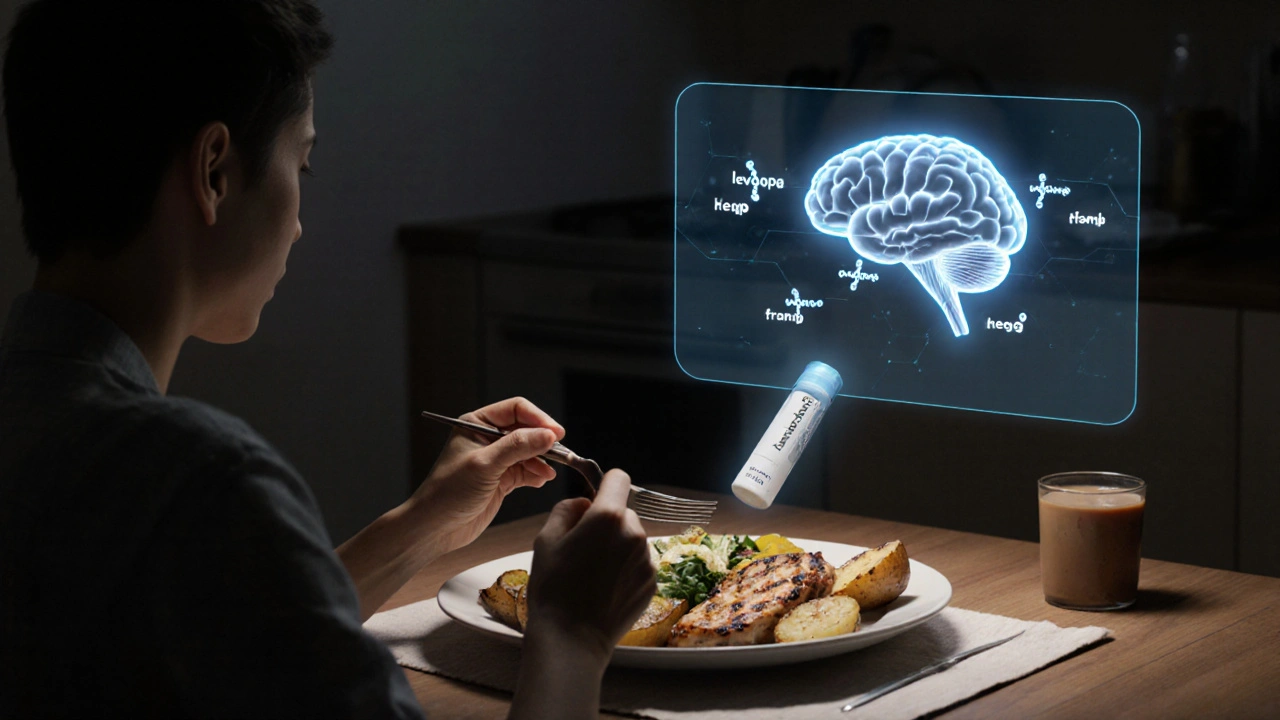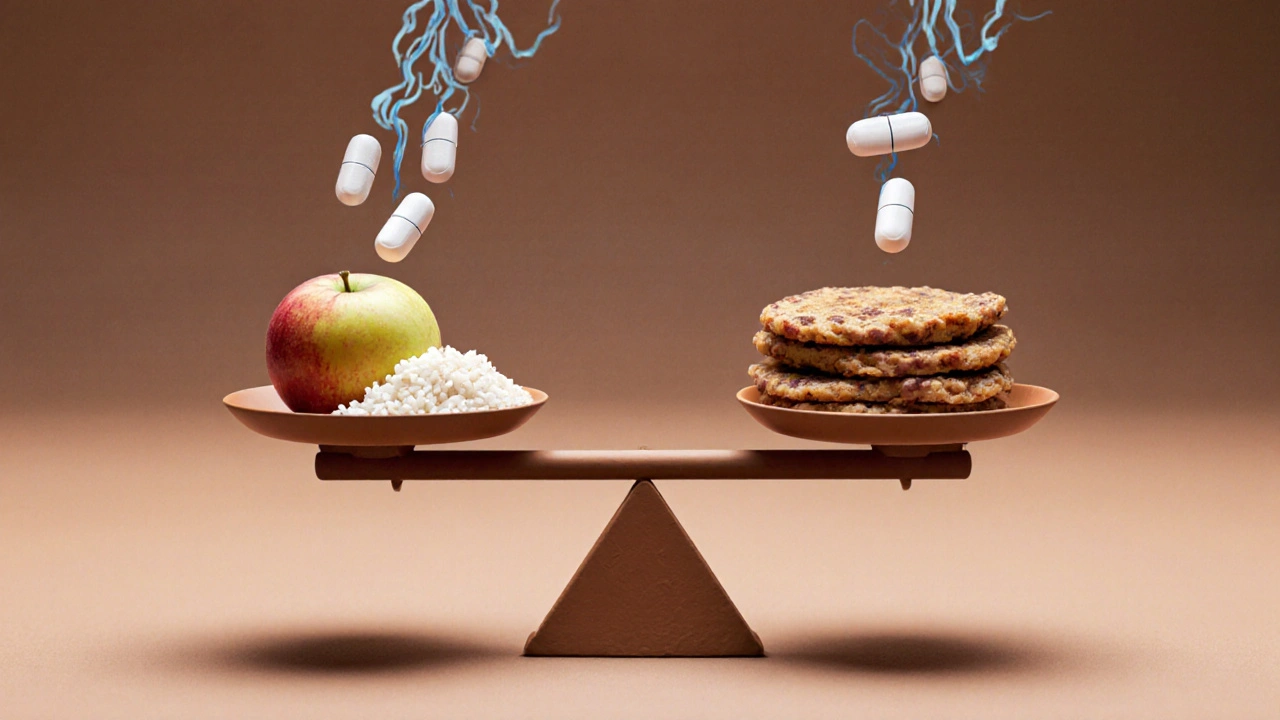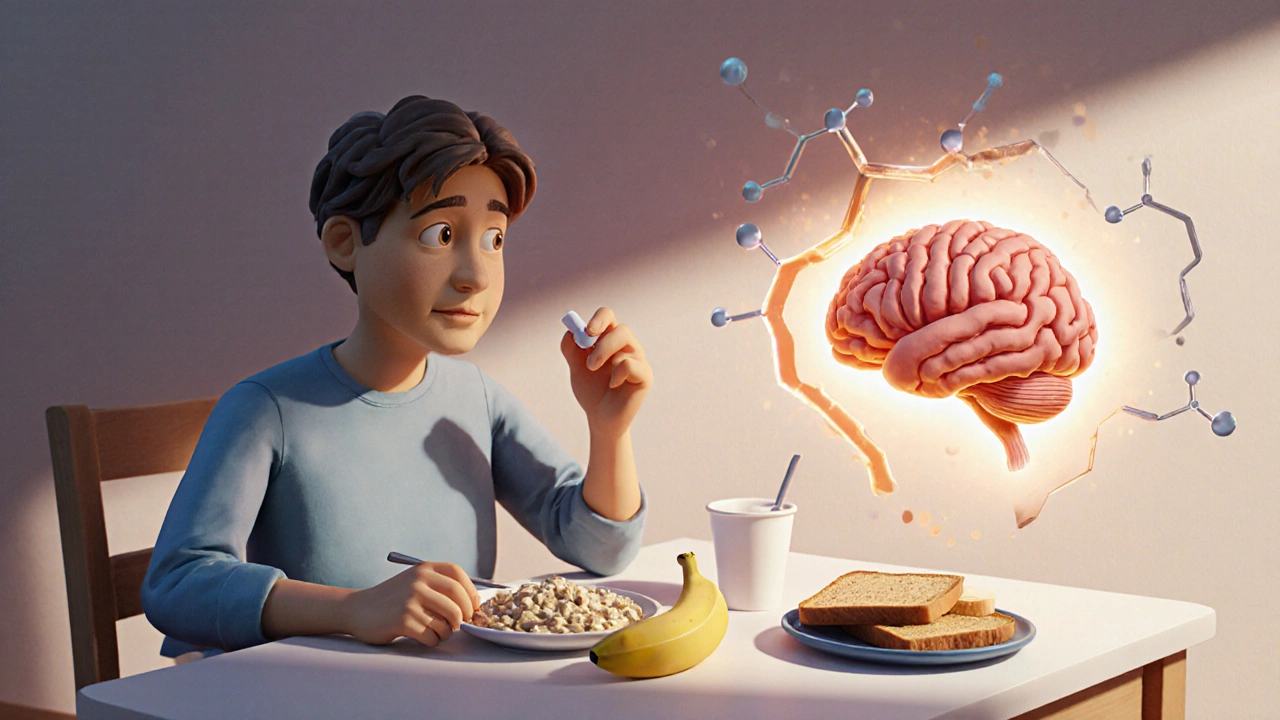Levodopa Protein Timing Calculator
Levodopa absorption can be reduced by 25-40% with meals containing more than 10g of protein. The Protein Redistribution Diet (PRD) moves most protein to dinner to maximize medication effectiveness during your active hours.
Breakfast
Lunch
Dinner
PRD Recommendation
For optimal levodopa absorption, aim for 10-15g protein at breakfast and lunch combined, and 50-60% of your total protein at dinner.
Your Results
With your current distribution, you may experience hours of reduced 'off' time daily.
Important Considerations
Your current protein distribution may cause grams of protein to interfere with levodopa absorption.
Low-Protein Breakfast Options
- Oatmeal (2g protein per 1/2 cup)
- Fruit (bananas, berries)
- Toast (1-2 slices)
- Unsweetened almond milk
Low-Protein Lunch Options
- Vegetable soup (no meat)
- Salad with olive oil dressing
- Rice or pasta with vegetables
- Cucumber, tomato, and avocado salad
High-Protein Dinner Options
- Chicken breast (30g protein per 100g)
- Fish (20g protein per 100g)
- Tofu (10g protein per 100g)
- Legumes (15g protein per 1/2 cup)
If you or someone you know takes levodopa for Parkinson’s disease, what you eat could be quietly sabotaging your medication. It’s not about sugar, caffeine, or gluten-it’s about protein. For many people with Parkinson’s, eating a normal protein-rich meal can turn a good ‘on’ period into a sudden, disabling ‘off’ episode. This isn’t a myth or a suggestion-it’s a well-documented, biologically real interaction that affects up to half of long-term levodopa users.
Why Protein Interferes with Levodopa
Levodopa doesn’t just float freely into your brain. It needs a special gatekeeper: the large neutral amino acid (LNAA) transporter, also called LAT1. This transporter is found in your gut and across the blood-brain barrier. It’s designed to carry essential amino acids-like leucine, phenylalanine, and tryptophan-from your food into your bloodstream and then into your brain. The problem? Levodopa looks just like these amino acids. When you eat a steak, a bowl of beans, or even a glass of milk, your body breaks down the protein into these same amino acids. Suddenly, there’s a traffic jam at the transporter. Your body can’t tell the difference between the amino acids from your food and the levodopa you just took. So, the levodopa gets stuck waiting in line-and that means less of it reaches your brain. Studies show that a meal with more than 10 grams of protein can reduce levodopa absorption by 25-40%. A typical lunch with chicken, rice, and yogurt might contain 30-40 grams of protein. That’s enough to delay levodopa’s peak effect by 45 to 90 minutes. For someone already struggling with movement, that delay can mean the difference between walking across the room and being stuck on the couch.When Does This Start to Matter?
This isn’t something that happens right away. Most people start noticing the problem around 8 to 13 years after beginning levodopa therapy. That’s when the brain’s ability to store and release dopamine naturally starts to fade. Levodopa becomes the only source of dopamine-and when it doesn’t get through, symptoms crash. You’ll know it’s happening if you start having unpredictable ‘off’ periods. Maybe you feel fine after taking your pill, but 30 minutes after eating lunch, your hands shake again. Or you wake up stiff and slow, even though you took your night dose. These aren’t random bad days-they’re likely tied to protein timing.The Three Dietary Strategies That Work
There are three main ways to manage this. None are perfect. But one stands out as the most effective for most people.- Low Protein Diet (LPD): This means cutting total daily protein to 40-50 grams-roughly half of what most adults eat. For a 70kg person, that’s about one egg, a small piece of chicken, and half a cup of lentils. It sounds simple, but it’s hard to stick to. Many people lose weight, feel weak, or get nutrient deficiencies. It’s rarely sustainable.
- Protein Redistribution Diet (PRD): This is the gold standard. Instead of cutting protein, you move almost all of it to your evening meal. Breakfast and lunch stay low-protein-think oatmeal, fruit, toast, vegetables. Dinner is when you eat your steak, fish, or tofu. Why does this work? Because levodopa works best during the day, when you need mobility. At night, you don’t need to walk or talk as much. Even if the medication doesn’t work as well after dinner, it doesn’t matter as much. Studies show PRD reduces ‘off’ time by nearly two hours a day and adds 30 minutes of reliable ‘on’ time.
- Low-Protein Products (LPP): These are specialty foods-low-protein bread, pasta, and flour-that let you eat more volume without hitting your protein limit. They help with variety, but only 22% of users say they’re satisfied with them. They’re expensive and hard to find outside the U.S. and Europe.

Why PRD Works Better Than Cutting Protein
PRD isn’t just about timing-it’s about balance. You’re still getting all the protein your body needs. You’re not starving. You’re just rearranging when you get it. A 2016 study found that people on PRD had 35% fewer motor fluctuations than those on a standard low-protein diet. Why? Because your body doesn’t get overwhelmed with amino acids during the day. The transporter stays clear for levodopa when you need it most. But here’s the catch: PRD only works if you’re consistent. One high-protein breakfast can undo a week of good planning. That’s why many people give up.Real People, Real Struggles
A woman in Bristol told her neurologist she couldn’t eat her Sunday roast anymore. She missed family dinners. Her grandchildren didn’t understand why she only ate salad. She lost 6% of her body weight in three months. Another man, 71, started taking levodopa 45 minutes before breakfast. He switched to scrambled eggs and toast for morning meals. He kept his chicken and potatoes for dinner. Within two weeks, he was walking his dog again without help. He didn’t lose weight. He didn’t feel deprived. He just changed the schedule. Social isolation is the biggest hidden cost. Nearly 60% of people with Parkinson’s say dietary restrictions have hurt their relationships. Eating out becomes a minefield. Restaurant meals are full of hidden protein-sauces, dressings, cheese, nuts. Even a ‘healthy’ salad can have grilled chicken, hard-boiled eggs, and beans.What Works in Practice
If you’re trying this, here’s what actually helps:- Take levodopa 30-60 minutes before meals. This gives it a head start. If your stomach is empty, it absorbs faster.
- Track your protein. Use MyFitnessPal or a simple food diary. Write down what you eat and when you take your meds. Look for patterns. Did you feel worse after pasta with meat sauce? That’s your clue.
- Use low-protein swaps. Try low-protein bread (2g protein per slice instead of 8g), rice noodles, or vegetable-based meals. These aren’t magic, but they help stretch your protein budget.
- Try a ‘protein holiday.’ Pick one meal a week-usually dinner-to eat normally. It’s not a cheat day. It’s a planned reset. Many people find this makes long-term adherence possible.
- Work with a dietitian. 78% of people who get professional help see better results than those who try alone. A dietitian can help you design meals that fit your culture, preferences, and budget.

Who Shouldn’t Try This?
Not everyone needs to cut protein. Only 40-50% of people on levodopa have a clinically significant interaction. If you’re still moving well, your symptoms aren’t fluctuating, and you’re not losing weight-you probably don’t need to change anything. Also, if you’re underweight (BMI under 20), don’t restrict protein. You need every gram to stay strong. The same goes for people with swallowing problems, recent weight loss, or poor appetite. For them, getting enough calories and protein matters more than perfect medication timing.What to Watch For
Changing your diet can cause new problems:- Weight loss. 31% of people on strict low-protein diets lose more than 5% of their body weight in six months. That’s dangerous for someone with Parkinson’s.
- Nutrient gaps. Long-term PRD users often lack vitamin B12, iron, and zinc. Get blood tests every 6-12 months.
- Medication adjustments. If PRD works, your doctor might reduce your levodopa dose by 15-25%. Why? Because your body is absorbing it better. Too much levodopa can cause dyskinesias-uncontrolled movements.
The Future: Smarter Solutions
Scientists are working on better ways to fix this. One new approach, called ‘protein pacing,’ is in clinical trials. Instead of eating all your protein at night, you spread tiny amounts throughout the day-like 3 grams per meal. Early results show 68% of people respond well, with fewer side effects and better adherence. Another idea is a new form of levodopa that doesn’t need the amino acid transporter. If it works, it could change everything. But for now, the best tool we have is timing and planning. It’s not glamorous. It’s not a pill. But for thousands of people, it’s the difference between being able to tie their shoes or not.Can I eat protein if I take levodopa?
Yes-but timing matters. Eating protein at the same time as levodopa can block its absorption. The best approach is to take levodopa 30-60 minutes before meals, especially breakfast and lunch. Save most of your protein for dinner, when you don’t need maximum mobility.
How much protein is too much for someone on levodopa?
A meal with more than 10 grams of protein can start to interfere with levodopa. A typical lunch with chicken, rice, and yogurt can have 30-40 grams. For most people on long-term levodopa, aiming for 40-50 grams of protein total per day-with most of it at dinner-is a good target. A dietitian can help tailor this to your weight and needs.
Is a low-protein diet safe long-term?
Not for everyone. Strict low-protein diets can lead to muscle loss, weakness, and nutrient deficiencies like low B12 or iron. They’re not recommended for people who are underweight or have poor appetite. Protein redistribution (PRD)-moving protein to dinner-is safer and more sustainable for most people.
Why does protein affect levodopa but not other Parkinson’s meds?
Levodopa is an amino acid analog, so it uses the same transport system as dietary amino acids. Other Parkinson’s medications-like dopamine agonists (pramipexole, ropinirole) or MAO-B inhibitors (rasagiline)-don’t rely on this transporter. That’s why protein doesn’t interfere with them.
Should I stop eating meat or dairy if I have Parkinson’s?
No. You don’t need to eliminate meat or dairy. You just need to time them right. Move high-protein foods like meat, eggs, cheese, and beans to your evening meal. Keep breakfast and lunch light-focus on fruits, vegetables, rice, pasta, and bread. This way, you get the nutrition you need without blocking your medication.
How long does it take to see results from protein redistribution?
Most people notice improvements in motor control within 1-2 weeks. But it can take 3-6 weeks to fully adjust to the new eating pattern. Keeping a diary of your symptoms and meals helps track progress. Many people report gaining 1-3 extra hours of good ‘on’ time each day.
Can I still eat out at restaurants?
Yes, but plan ahead. Choose dishes with vegetables, rice, potatoes, or pasta as the main component. Ask for sauces on the side and skip meat, cheese, beans, and eggs. Many restaurants will accommodate special requests if you explain you’re managing a medication interaction. It’s not about being difficult-it’s about staying mobile.

